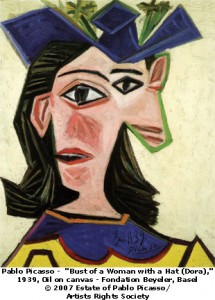Fakes and the Fools Who Fall for Them – by Rosemary Trietsch
January 14th, 2010 by admin Every collector has occasion to wonder if the item they just got a great deal on is the real thing or a clever fake. Face it, as much as we all love a bargain, we’re haunted by the ‘too good to be true’ motto. Much of this fear can be alleviated if you buy a book or two about your chosen collectible, and if you keep up with what’s going on in the market – Collector organizations work very hard to maintain databases of the fakes that are out there.
Every collector has occasion to wonder if the item they just got a great deal on is the real thing or a clever fake. Face it, as much as we all love a bargain, we’re haunted by the ‘too good to be true’ motto. Much of this fear can be alleviated if you buy a book or two about your chosen collectible, and if you keep up with what’s going on in the market – Collector organizations work very hard to maintain databases of the fakes that are out there.
Of course, books and data bases aren’t any good when you’re standing in a wet field with a flashlight at 5am, trying to figure out exactly what you’re looking at. What’s a collector to do? Well, here are a few questions to ask yourself before you spend any money.
First, am I really seeing what I think I’m seeing? Often, the difference between a common item and a rare one comes down to the tiny details.(The 6 inch tumbler is common while the 6 ¼ inch size is super rare. Or the yellow trim scarf was mass produced, while the green trim was a limited run.) Make sure you know the details.
Second, how many are you looking at? We all find bargains, but if you come across an item that’s well documented as rare and a seller has 4 of them, or 4 sellers in the same mall each have one, that should set off your ‘repro-radar’.
Once you handle the item, ask yourself question three: does it feel right? Is it too heavy or too light? Too rough or too slick? Many folks are surprised to discover that their tactile memory is one of the best tools they have to detect fakes. You’ve handled enough authentic items to know when something just doesn’t feel right in your hands.
Fourth, is the craftsmanship consistent with the age? Check for new screws and nails, glue or paint where it shouldn’t be, or that wasn’t around at the time the item was supposedly produced. Once again, the devil is in the details.
Fifth, is the wear consistent with the age? Old items have signs of use. Make sure the wear marks are not too regular – like those created when sandpaper is deliberately rubbed over a finish to ‘give it character’.
Last of all, is the label/mark consistent with authentic items you own? Signatures and labels are the easiest thing to fake. Thankfully, forgers are pretty dumb. If there’s a zip code on the label of a purported ‘authentic 18th century’ chair, you know it was actually made after 1963. Likewise, if Cambridge is spelled ‘Cambirge’…well, need I say more? Also, if the mark is always raised and this one is engraved, you’re looking at a ‘La-yuck’ instead of a Lalique.
Trust your instincts. You know more than you realize, so listen to your ‘inner collector’ – he’s smarter than you think.
